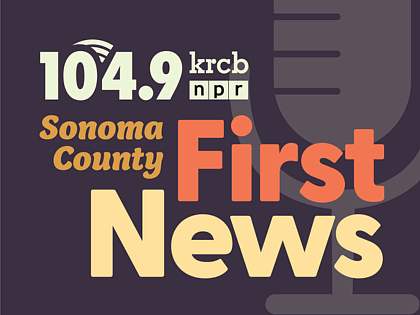
- Written by: Steve Mencher
 In an article from the public media journal Current, Northern California Public Media was recognized this week for its efforts to ramp up communication with our Spanish speaking neighbors. Of particular interest to writer Grace Vitaglione was the organization's bilingual approach to its 13-week run of Coronavirus Town Halls.
In an article from the public media journal Current, Northern California Public Media was recognized this week for its efforts to ramp up communication with our Spanish speaking neighbors. Of particular interest to writer Grace Vitaglione was the organization's bilingual approach to its 13-week run of Coronavirus Town Halls."During the COVID-19 pandemic, KRCB is adding Spanish voiceovers of its virtual town hall broadcasts about the coronavirus with the original English versions," Vitaglione wrote. "The station also held a panel with leaders in the area’s Latino community.
"[News director Steve] Mencher said his goal is not to have 'separate but equal' news in Spanish and English but to allow people to get Spanish-language news in 'real time,' which led to the idea of providing the voiceovers."
In order to record the Spanish voiceover for postproduction, assistant news director Adia White transported digital recorders each week to La Mejor radio. NorCal CEO Darren LaShelle worked through the details of the arrangement with La Mejor management. Producers Yinka Adeboyejo and Joshua Mellars married the English and Spanish files for posting on the NorCal website each Wednesday.
- Written by: Kacey Sycamore
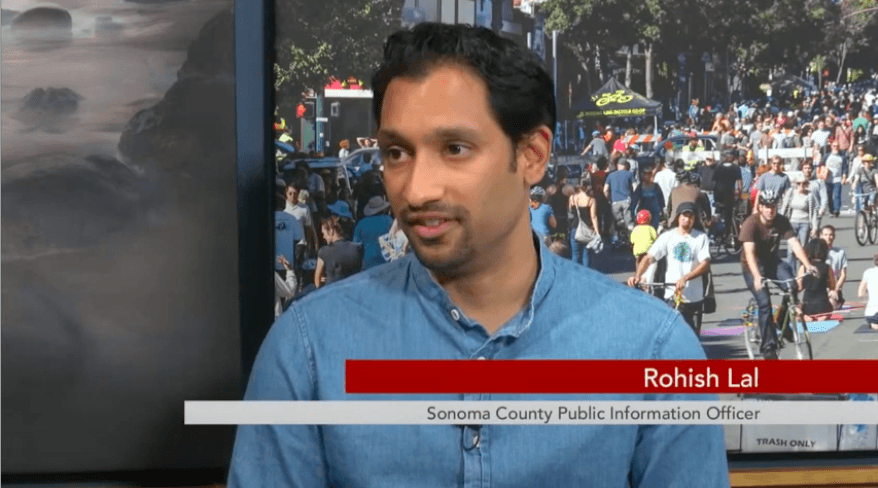
We put the call out for your questions related to the coronavirus pandemic, and you’ve asked about where you can find ongoing information, how the recent protests will affect COVID-19 case counts, access to testing and more.
Here’s what we learned from the experts during our June 2 Town Hall. Even though this was our last scheduled live Town Hall program, we will continue to cover the pandemic. Find more information below.
Last week you announced this would be the last town hall meeting. It's been very informative. Why are you stopping? Where can we get info?
Although Tuesday’s Town Hall was our last scheduled program, we will still be covering the coronavirus pandemic in our radio and TV news reports and online at NorCalPublicMedia.org. (Currently, we do daily coronavirus updates at 9:00 a.m. and 6:45 p.m. )
After 13 weeks, we felt that our weekly live TV program had run its course and we will be reassessing how we can best share information, including in smaller bites on social media.
This particular moment has reinforced the idea that the November, 2020 elections will be critical as we move collectively to choose our leaders both locally and nationally. We are going to be expending our resources to follow the issues that are important to our community, beginning with a “just recovery” from the pandemic. We’ll be paying special attention to the fact that COVID-19 cases are far more prevalent in the Latinx community than in other local groups.
Let us know how you want us to communicate ongoing coronavirus news by using the submission form to the right and marking "Future coronavirus coverage" for the question category.
Sonoma County Health Officer Dr. Sundari Mase also provides updates daily at 3:30 p.m. on Facebook live on the county’s page.
You can continue to submit questions at norcalpublicmedia.org/coronavirus, and we will keep using them to inform the direction of our reporting. When possible, we will answer them directly, and we even have hopes of involving some of you in our reporting.
How will public health trace contacts for those at a protest?
Sonoma County Public Information Officer Rohish Lal says the public health department acknowledges people’s right to protest, and if a protester does end up testing positive for COVID-19, they will conduct contact tracing as they would in any other case, to the best of their abilities.
He advises protesters to wear facial coverings, maintain physical distancing of six feet when possible, keep their hands clean and avoid touching their face.
What advice is there for testing for someone 65 and older, asymptomatic, with underlying conditions? And why are there no tests available outside the 101 corridor?
The county says that testing is a critical step in reopening which allows public health officials to identify and increase their understanding of community transmission. They want a broad sample of results from people with or without symptoms.
Dr. Mase has said you don’t typically need to get retested after an initial COVID-19 test.
“I think people need baseline testing, and then if they become symptomatic or if they’ve had an exposure to someone with COVID, then they should be retested,” she said.
If you go out to get tested, follow the same social distancing and hygiene protocols as you would at any other time.
Tests for asymptomatic members of the general public are available only in Petaluma and Santa Rosa, where most cases are concentrated. You can register to be tested here: https://lhi.care/covidtesting
By design, testing is most available in population centers in the county, but community health clinics throughout the county are taking the lead in making sure that everyone who needs a test gets one.
Watch Tuesday's Town Hall program here:
Do you have a coronavirus-related question? Submit it using the form at the right or at norcalpublicmedia.org/coronavirus.
- Written by: Kacey Sycamore
 By Ben Christopher, CalMatters
By Ben Christopher, CalMatters
Depending on your viewpoint, now is either exactly the right time or precisely the wrong time to take up a proposed change to the state constitution that seems certain to reignite a heated debate about race and justice in California.
At issue: a measure pending in the Legislature that seeks to reinstate affirmative action policies jettisoned by California voters two decades ago.
For supporters, events of the past week— city streets across the country filled with peaceful protesters and then scattered window smashing, thefts from store shelves and a few incidents of violence — show just how necessary it is to aggressively advance racial equity by fiat.
(Image: California lawmakers are revisiting whether to restore affirmative action policies for public schools and universities, as well as state jobs and contracts. Image via iStock)
Recent headlines “are forcing us to recognize that we are not beyond race as a country or as a state,” said Audrey Dow, vice president of The Campaign for College Opportunity, a Los Angeles nonprofit that advocates for more expansive access to higher education in California. “We have not achieved the nirvana of being color blind. Race matters.”
Opponents include a politically organized contingent of Chinese American Californians and Ward Connerly, a former University of California Regent who campaigned to ban state affirmative action programs in the mid-1990s. They argue that allowing schools and state agencies to take race into account when making admission and hiring decisions is its own kind of injustice.
“God knows we’ve got enough things in this nation that Democrats and Republicans argue about,” he said. “Certainly there should be some value that we hold to be dear and not fight over, like whether all citizens should be treated equally.”
In 1996, just four years after the last time the National Guard was deployed to Los Angeles to put down unrest in response to police violence, California voters passed Proposition 209, a constitutional amendment to ban affirmative action at state institutions.
The measure prohibits California’s state colleges and universities from taking into account the race, ethnicity, gender or national origin of would-be students in the admissions process. It also prevents state agencies from using such criteria in its hiring decisions or when awarding contracts for goods and services.
The Legislature can’t undo Prop. 209 on its own. Democratic Assemblywoman Shirley Weber of San Diego introduced Assembly Constitutional Amendment 5— a measure that, if passed by two-thirds of both the Assembly and Senate, will go before the voters on the November ballot.
A repeal of Prop. 209 would not mandate that state schools and agencies adopt affirmative action programs. But it would allow them to create employment or admission programs that explicitly take the race, gender or national origin of an applicant into account.
For some moderates and even some conservatives in Sacramento, the fact that the measure will present the question to voters rather than providing an answer unilaterally has been a vital distinction. In the Public Employment and Retirement committee earlier this month, Republican Assemblyman Randy Voepel, not known as a moderate, voted to pass it out of committee.
Prop. 209, he noted, had been passed by voters one “biblical generation” ago.
“This has got to go before the people of California of this generation,” he said, noting he had not yet decided how he would vote if the proposed constitutional amendment comes before the entire Assembly.
That will have to happen soon. Legislators have until June 25 to pass all potential ballot measures through both chambers. Repealing the affirmative action ban would be a heavy political lift even if the state’s extended shelter-in-place order hadn’t shortened the legislative calendar. It’s also made the in-person schmoozing that whipping votes often requires nearly impossible.
“I can’t get in their face and whisper in their ear, ‘You know you need to help me,’” Weber told Voice of San Diego.
Earlier this year, Assembly Speaker Anthony Rendon refused to endorse the effort. Though he said he supports the eventual repeal of Prop. 209, “if we are going to get something on the ballot, get it passed in November, from a political standpoint, it almost seems too late,” he told CalMatters. And that was in January, before the pandemic.
But with Weber’s proposal set to go today before the Assembly Appropriations Committee, chaired by San Diego Assemblywoman Lorena Gonzalez, a co-author, Connerly unhappily thinks the odds are in the measure’s favor.
“I will not be surprised if it passes the committee, the Assembly, the Senate,” he said.
In 1998, the year Prop. 209’s affirmative action ban kicked in, admission rates for black and Latino students across the University of California system dropped 10 percentage points for black students and 7 percentage points for Latino students compared to the previous year, according to admissions data. The numbers were much larger at the most competitive schools within the system — UC Berkeley and UCLA. A study commissioned by the UC Office of the President estimated that the system-wide affirmative action program that was in effect prior to 1998 increased the number of Latino, black and Native American students systemwide by 12%.
“The universities never recovered from 209 in terms of access for students of color,” said Gary Orfield, co-director of the Civil Rights Project at UCLA’s Graduate School of Education. “And there hasn’t been much progress across the state in diversifying faculties.”
Latinos, for example, make up 6% of professors and lecturers across the UC system.
Supporters of affirmative action argue that “race blind” admission policies that select applicants based on purportedly objective metrics like SAT scores or recommendation letters only reenforce existing inequalities. Such systems award coveted enrollment slots or jobs to those who can afford expansive test prep courses or who live in rarified social circles, the argument goes. Trying to bridge those racial chasms indirectly by using non-racial criteria like where an applicant lives or their family’s household income is tantamount to “willful ignorance” of the underlying issue, said Vincent Pan, executive director of Chinese for Affirmative Action, a nonprofit headquartered in San Francisco’s Chinatown.
For example, he said, “if you want to support Asian-owned businesses that have been affected by COVID-related racism, we should just have a program that supports Asian-owned businesses that have been affected by COVID-related racism.”
This is not the first legislative broadside against Prop. 209. In 2013 former Sen. Ed Hernandez introduced a similar repeal, applying only to public schools. That passed the state Senate on a party-line vote, but then faced fierce opposition from a coalition led by Chinese American social justice organizations. Their argument: Affirmative action policies in higher education would discriminate against Asian American applicants.
After a massive call-in, letter writing and capital lobbying campaign from opponents, Assembly Democrats refused to even put the measure up for a vote.
“We would never support a policy that we believed would negatively impact our children,” Assemblymembers Ted Lieu, Carol Liu, and Leland Yee — all Democrats — wrote at the time. The Wall Street Journal’s conservative editorial board referred to the campaign as “California’s Asian Spring.”
Opponents of Weber’s ACA 5 are counting on another wave of public pushback.
Wenyuan Wu, administrative director for the Asian American Coalition for Education, a national nonprofit, said so far there has been significantly more coverage of the issue in California’s Chinese-language press than in English-language outlets. Advocates, she said, have been organizing on WeChat, the Chinese messaging and social media app.
Yukong Zhao, president of the coalition, is a Republican candidate for Congress in Florida.
The reason that Chinese American Californias are among the most vocal opponents is obvious, Wu said.
Under any affirmative action system, “when a particular group of students are deemed as overrepresented,” she said, ”they stand to lose, they stand to be hurt by these kinds of admission practices.”
“Granted, there are inequities and structural issues that are rooted in deeper causes like unequal K-12 public education and deeper socioeconomic disparities,” said Wu. “But I don’t think ACA 5 is the issue. And in this case, I think the medicine might be worse than the disease.”
A national survey of Asian Americans in 2016 found that a majority of respondents supported affirmative action programs “designed to increase the number of black and minority students on college campuses,” compared to 32% who did not. Of the six national origin groups surveyed — Indian, Chinese, Filipino, Japanese, Korean and Vietnamese — only a majority of Chinese-American respondents opposed the policy.
“We know that there is some intense mobilization in some parts of the Chinese community but we try hard to help explain that actually the Asian American community is quite diverse,” said Pan of Chinese for Affirmative Action. Pan is also the co-chair of Opportunity for All, an umbrella advocacy group pushing to repeal Prop. 209.
He said that much of the opposition to Hernandez’s bill in 2013 came from relatively new immigrants, many of whom, he said, were misinformed about what the bill would actually do in a “cynical attempt by oftentimes white conservatives to exploit those concerns and direct them against race-conscious and gender-conscious policies.”
For decades, the U.S. Supreme Court has upheld the constitutionality of affirmative action programs, but on increasingly narrow grounds. Specific race or gender quotas were ruled unconstitutional in 1978. But the court held that schools may consider race as one of many factors when evaluating an applicant.
“Considerable deference is owed to a university in defining those intangible characteristics, like student body diversity, that are central to its identity and educational mission,” Justice Anthony Kennedy wrote in a high-profile affirmative action case in 2016.
But Kennedy is no longer on the nation’s highest court, and the bench has swung decidedly to the right. Chief Justice John Roberts, the court’s ideological center and frequent swing vote, has in the past taken a dim view of racially explicit policy.
In a 2005 case brought against the Seattle School District’s desegregation plan, which took into account a student’s race in determining which high school they ought to attend, Roberts wrote that “the way to stop discrimination on the basis of race is to stop discriminating on the basis of race.”
The court is likely to take up the issue of affirmative action in higher education again soon.
Students for Fair Admissions, a nonprofit run by conservative litigant and activist Edward Blum, sued Harvard arguing that its race-conscious admission policy represents “intentional discrimination against Asian Americans.” That case is awaiting a decision by a federal appellate court, but both sides have vowed to take the fight to the Supreme Court.
Whatever the high court does, Pan said that repealing California’s ban on affirmative action is still worthwhile.
“The right thing to do is always the right thing to do,” he said. “The best way to address racism and sexism is to address racism and sexism.”
- Written by: Kacey Sycamore
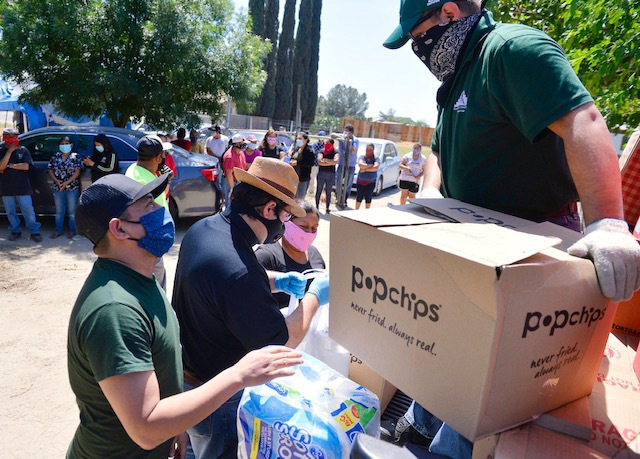 By Cresencio Rodriguez-Delgado, The Fresno Bee/California Divide
By Cresencio Rodriguez-Delgado, The Fresno Bee/California Divide
On a recent hot Saturday, residents in a small tract of homes west of Fresno huddled under the shade to wait for a distribution of hygiene products and food.
Many of those who waited in lines for toilet paper, canned food and masks learned about the giveaway through organizer Lilia Becerril’s growing social media following.
While such products are essential in the fight against COVID-19, getting them in the hands of the people how need them is challenging, especially in rural areas that lack both a city government structure and a dedicated local news source, according to Becerril, a Fresno resident.
(Image: The pandemic is worsening the digital divide as immigrant and low-income communities search for ways to inform residents. Two volunteers from the Education & Leadership Foundation help unload essentials for distribution to farmworkers Saturday afternoon, May 9, 2020 near Rolinda, CA. Photo by Eric Paul Zamora/The Fresno Bee )
Since the coronavirus pandemic spread to the central San Joaquin Valley in early March, Becerril has picked up efforts on three Facebook pages she runs to get out information about food distributions, coronavirus testing centers, and how residents can get unemployment relief. Similar efforts are playing out across California where the digital divide is greatest in immigrant and low-income communities with limited internet access. Even when people are connected, there’s often a lack of understanding about where to find trusted sources of news.
“Information can get lost,” Becerril said. “Right now, above all else, we are in a crisis, and we have no choice but to get plugged in.”
She estimates helping around 500 families over the last two months, many of whom are farmworkers or recently unemployed and were cut out of government financial aid packages. She said those residents, who often live in areas with poor Internet connectivity, have struggled for many years to get reliable local information.
The coronavirus pandemic worsened the needs, she said.
“If this crisis is affecting me, how is it affecting other people?” Becerril said. “I have been fortunate that the information I share has helped me gain the trust of people.”
She worked with a variety of local organizations to connect with families most in need. Those efforts have helped families keep up with utility bills and groceries and provided protective gear like face masks.
A recent study from the UCLA California Policy Lab noted people of color, the eldery and women and children have born the brunt of the effects of the coronavirus pandemic. Those are also many of the same people Becerril and others in the Valley have organized to help in recent years.
Becerril, who speaks limited English, said her community involvement began after seeing school kids near her home a few years ago make paper airplanes out of school fliers. Her neighbors were parents who only spoke Spanish, and she thought the information from the school wasn’t reaching them. Today, her social media bulletins reach thousands.
Health agency response
In one of the hardest-hit counties by COVID-19, Tulare County Health and Human Services Agency officials say they began early to reach out to communities with language needs and those who don’t typically seek public health messages.
Tammie Weyker-Adkins, the spokeswoman for the department, said the agency increased its use of digital outreach and fliers to reach residents in different languages. Like many in the state, the agency has regularly updated its online followers on the county’s coronavirus situation since it began.
“I do feel like we have really used that to our advantage to try to get information out to folks,” Weyker-Adkins said. “Effectively communicating information to the right audience at the right time with the right information, that is vital.”
At the start of May, the Tulare County health office began airing radio messages targeting Latino and Asian residents. The effort is funded through a grant from the government-run Listos California, a statewide disaster preparedness campaign. The county also set out to distribute postcards to seniors and face masks for the homeless with information printed about the virus and how to stay safe, Weyker-Adkins said.
Although she believes the county had time to prepare, Weyker-Adkins said the public health disaster has still left many with questions. She said the county has tried to learn how best to reach out to residents who may not be following state orders aimed at limiting the spread of the virus.
“You don’t really get that experience unless you’re either thrown into a disaster or get some training,” Weyker-Adkins said. “Even with the preparation, when you’re in the midst of it, it’s definitely a different animal.”
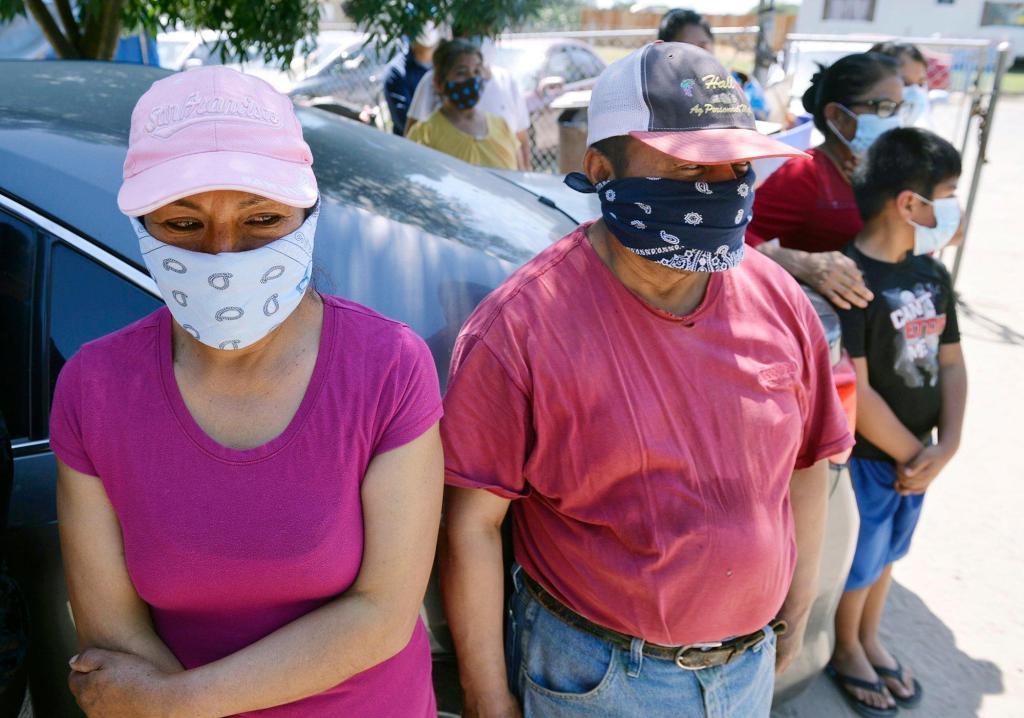
Reaching rural residents
In many small Valley cities, many residents work outdoors and rely on word-of-mouth for much of their information, said Juan Carlos Mosqueda, an Orosi resident and student at College of Sequoias in Visalia.
“They talk about it in the workplace,” he said.
Mosqueda said getting fast, reliable information is seen as a luxury for residents where he lives. His parents, who are farmworkers, often tune in to Spanish radio on drives to work at fruit farms and catch TV news segments in the afternoon. But the information doesn’t always apply directly to them.
“In a community where people do really hard labor, they don’t have the energy to connect like other places,” Mosqueda said.
For community advocates, combating the economic and social effects of the virus includes making sure residents aren’t getting the wrong information.
(Image: Masked farmworker families stand waiting for donated food and much needed wares including surgical masks Saturday afternoon, May 9, 2020 near Rolinda, CA. Photo by Eric Paul Zamora/The Fresno Bee)
Leslie Martinez, a policy advocate with Leadership Counsel for Justice and Accountability, said word of mouth could often be misleading if residents are not getting the correct information in the first place. She said residents in Lanare, a small unincorporated community in southwest Fresno County, have been left confused in recent weeks on issues like rent and utility shutoffs.
At the same time, Martinez told The Bee she has felt “radio silence” in attempts to reach county supervisors or government offices for information.
‘News deserts’ during COVID
Carolyn Powers, program manager for the Listening Post Collective at InterNews, said government officials like supervisors have “a big role” in informing residents during a crisis.
That’s especially true as many communities go without a local news service or live in areas where information is hard to reach. These communities, known as “news deserts,” have become increasingly concerning during the pandemic since they tend to affect rural areas the most, Power said.
But there have been efforts recently, following a 2019 study of the Valley’s news ecosystem, to increase information in communities that need it. The Listening Post Collective released a study late last year in which the group examined the news consumption habits of Black, Latino and Asian residents in rural areas.
The study found the residents most cared about getting information on health, housing and school — issues that have become increasingly of interest during the pandemic. Following the study, the Post Collective gave grants to different news projects in the Valley aimed at disadvantaged communities.
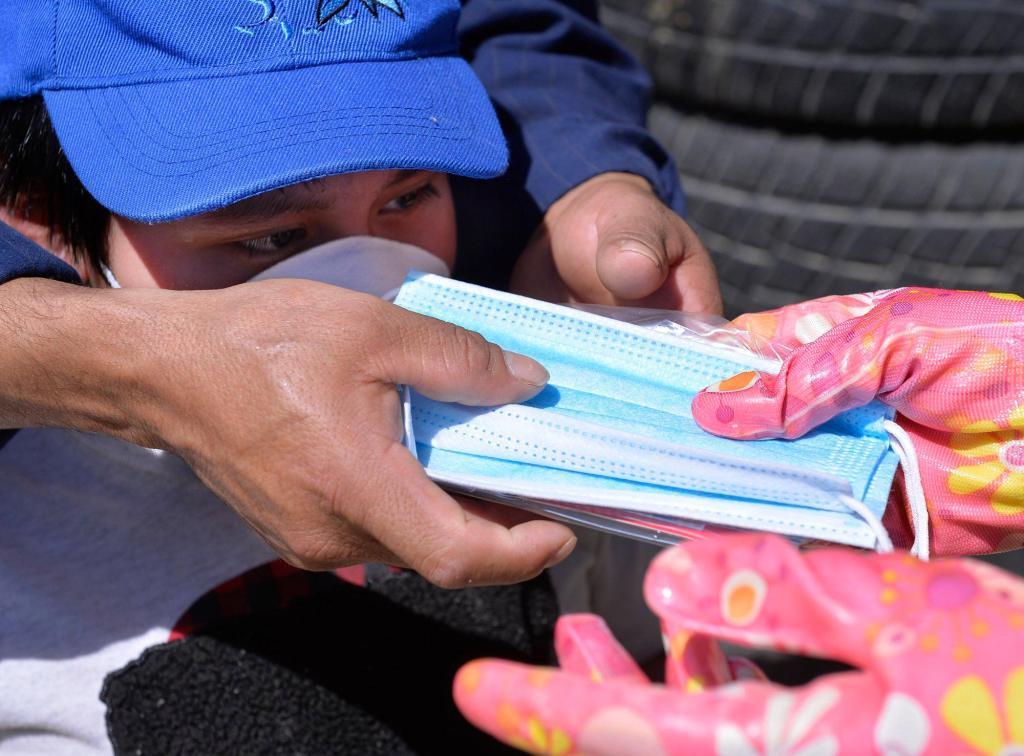
Information projects
One of the news projects funded after the study includes The Ivanhoe Sol, a nonprofit newspaper run with the help of volunteers.
The printed newspaper is mailed to every home in Ivanhoe, a community of about 4,500 residents in Tulare County. It provides information about business closures, job openings and available aid resources.
Layoffs at school districts and other businesses have recently affected Ivanhoe residents, Editor in Chief Pedro Hernandez said. In one of its first issues, the newspaper included steps on how to apply for unemployment. Information is often written in Spanish and English.
(Image: Surgical masks are distributed by Lilia Becerril and the volunteers she organized for farmworkers Saturday afternoon, May 9, 2020 near Rolinda, CA. Photo by Eric Paul Zamora/The Fresno Bee)
Hernandez said getting the paper delivered to each home has been an effective way to keep the older residents informed who otherwise would have to rely on their phones or television for local information. That’s a challenge with high-priced and unreliable Internet, he and the newspaper’s volunteers said.
“There is a shift to the digital interface, but in a place like the Valley, it’s not a guarantee,” Hernandez said. “(Mail) is really one of the only ways of reliable communication between you and an entity. I view the postal service as the backstop for all the other forms of communication. It worked before the Internet was created.”
But other efforts also are being made online.
Sergio Cortes, a co-founder of the Fresno-based digital media platform USpark Valley, said reaching younger people to inform them about the pandemic’s effects has also been important since younger groups don’t tend to follow the news closely. USpark Valley also received a Post Collective grant.
Cortes said the platform doesn’t compete with other news sources, instead he and his small team aggregate and cite information already published by others around coronavirus and other issues, then distributes it in digital platforms, like Instagram and Twitter.
“This is really affecting our communities in really deep ways,” Cortes said. “Just because it’s in the news all the time, it doesn’t mean it’s meeting all the demographics.”
Cresencio Rodriguez-Delgado is a reporter with the Fresno Bee. This article is part of The California Divide, a collaboration among newsrooms examining income inequity and economic survival in California.
- Santa Rosa Issues Citywide Curfew, 8 p.m. to 5 a.m., Each Night Through Thursday
- Hundreds Demonstrate Against Police Brutality; City of Santa Rosa Establishes Curfew
- 'InformaGente' - Health Dispatches to Latinx Communities
- Two Members of H.S. Class of 2020 Animate Call for Unity
- You Asked, We Answered: Your Questions About Reopening Hair Salons, Youth Sports And How Often To Get Tested
- Kaiser Disputes Health Professionals' Concerns on PPE
- Big Cuts Could Hit Little Californians: $1 Billion in Preschool and Child Care Dollars at Risk
- County Hiring Contact Tracers; Extra Pay for Being Bilingual
- We Need a Culturally Responsive Approach to COVID-19
- You Asked, We Answered: Your Questions About COVID-19 Hospitalizations, Senior Outings, and Visiting The Dentist
- Pandemic Food Stamps Offer Up to $365 Per Child
- Es Así Como un Déficit de 54.3 Mil Millones de Dólares Le Afectaría a Los Californianos
- Rep. Jared Huffman: $3 Trillion Bill is 'Opening Bid'
- Housing, Homelessness Funds Mostly Spared in Proposed Budget cuts
- Financial Help for California’s Undocumented Immigrants Starts Monday
- Sonoma County Voters Can Now Track Their Mail-In Ballot With New Program
- Watching for Signs of Child Sexual Abuse During Pandemic
- Virus Will Not Extinguish Wildfire Protection, Newsom Says
- Latinx Leaders Consider Coronavirus Toll in Sonoma County
- You Asked, We Answered: How Do I Apply for Unemployment If Under Asylum Status?
- Keeping The COVID Plague at Bay: How California Is Protecting Older Veterans
- COVID-Plagued California Nursing Homes Often Had Problems in Past
- Reopening in the COVID Era: How to Adapt to a New Normal
- Lawmakers Want to Know: What’s Up With That Half-Billion-Dollar Mask Deal?
- California Just Revealed a $54.3 Billion Deficit — Signaling Deep Cuts Ahead
- Radio Update: A California Union Victory, And Increased COVID-19 Testing
- Exclusive: California Wires Mask Dealer Half a Billion Dollars, Then Claws it Back
- Supervisors Hopkins and Rabbitt Discuss Phased Reopening
- California Readies Army of Coronavirus Detectives
- Radio Update: Supervisor Gorin Answers Questions About Fire Season, COVID-19 Testing
- Director of County Regional Parks Answers Questions About Revised Parks Closure Order
- Attorney for PG&E Fire Victims is Funded by Wall Street Firms He's Negotiating Against
- Sad Day for Many as Sonoma County Fair is Cancelled for 2020
- Cue the debunking: Two Bakersfield Doctors Go Viral With Dubious COVID Test Conclusions
- Not If, But How: California Prepares for an All Vote-by-Mail Election in November
- State Dashboard Tracks Daily COVID-19 Hospitalizations By County
- Health Care Provider Panel Highlights Hope, Progress
- Radio Update: Coronavirus Latest, Plus A Conversation With Santa Rosa Symphony's Music Director
- As Millions Navigate Unemployment, Local Organizations Rise to Help
- Coronavirus Could Force Private Practices To Close Or Sell — Raising Costs
- Coronavirus Detectives: Here’s How Counties Try to Track Everyone Exposed
- CHP Says It Will Stop Issuing Permits for Protests on State Property
- Sonoma County Activates “Warm Line” For Mental Health Calls
- Preguntas Comunes Acerca Del Coronavirus
- San Francisco Supervisor Ronen On How Pandemic Is Affecting Bay Area's Undocumented
- Predicting a Pandemic’s Path: What Models Can and Can’t Do
- Tips for Spotting Fake News Stories — And Where to Find Sources You Can Trust
- Newsom: Cities Blocking Hotels for Homeless Will Be ‘Judged’ by History
- Los Cien Sonoma County Hosts Congressmen for Virtual Coronavirus Town Hall
- Cut Farmworker Pay During the Crisis? Don’t Do It, California Growers Say
- Santa Rosa Police Begin Citing Businesses, Individuals for Violating Shelter-in-Place Order
- What Comes Next for California Cities? Deficits, Bailouts and Long Recoveries
- Acts of Grace from Everyday Californians Are Getting Us Through
- Recursos Alimentarios Durante COVID-19
- COVID-19: Leaders Discuss Food Insecurity and Safety
- Sonoma County Medical Facilities Must Screen Staff, Visitors for COVID-19 Symptoms and Require Masks
- Reopen California? That’s The Toughest Phase Yet, Newsom Says
- Undocumented Workers Face Obstacles Qualifying for Benefits During the Pandemic
- COVID-19: Food Resources
- Santa Rosa Fire Department Creates Pandemic Response Unit
- Kaiser Employees Receive Help With Child Care, Shelter and Extra Leave Under Union Agreement
- Sonoma County Human Services Department Answers Questions About Public Benefits During COVID-19
- Santa Clara County Says Shelter-In-Place Appears to Be Working, Provides COVID-19 Updates
- Santa Rosa CityBus to Further Reduce Service in Response to Pandemic
- California Offers Discounted Hotel Rooms to Health Workers Exposed to Coronavirus
- Here’s How Putting California’s Homeless in Hotels Actually Works
- Sonoma County To Establish Surge Hospital At Sonoma State University
- COVID-19: Recursos Para Indocumentados y Sin Beneficios
- COVID-19: Educational Resources for Learning at Home
- Covid-19 Business Roundtable: Sonoma County Is Hurting
- COVID-19: Resources for the Undocumented and Uninsured
- California Eases Child Care Regulations for Critical Workers
- Wear a Mask! OK, But What Kind?
- Without Shelter-In-Place Order, COVID-19 Patients Would Overwhelm Sonoma County Hospitals
- Asm. Wood Asks Public to Raise Awareness About Dangers of Domestic Violence Amid COVID-19
- COVID-19: Santa Clara County Resources
- A Coronavirus Property Tax Delay? Californians Shouldn’t Count On It
- Sonoma County Will Consider Property Tax Penalty Waivers on Case-by-Case Basis
- COVID-19: How to Help
- ‘Am I Going to Die?’ Alone and Scared, Confined Seniors Struggle with Anxiety
- Sonoma Joins Six Bay Area Counties And Extends Shelter-in-Place Order
- California Starts Recruiting Retired and Student Doctors, Nurses to Handle Surge in Severely Sick People
- New Model Projects Coronavirus Deaths In California Will Peak In Late April
- Santa Rosa Police Department Mourns Loss of Detective
- What is an Equitable Response to COVID-19: Interview With Ana Lugo
- California Ramps Up Output of Ventilators As COVID-19 Cases Grow
- COVID-19: Financial Resources for Sonoma County Residents
- Santa Rosa Outlines COVID-19 Support for Homeless
- Los Angeles Will Mirror New York As Coronavirus Surges, Newsom and Garcetti Warn
- COVID-19: Sonoma County Resources for Seniors and Vulnerable Populations
- Here’s What Happens to Science When California’s Researchers Shelter in Place
- COVID-19: Sonoma County Mental Health Resources
- Sonoma County Office of Education Recommends Schools Extend On-Campus Closures
- Undocumented Workers Struggle as Economy Grinds to a Halt
- All Parks Closed in Sonoma County
- Live Virtual Town Hall - Coronavirus: What You Need to Know – Tuesday at 7pm
- Sonoma County Sup. Susan Gorin Coronavirus Update 3-23-20
- SMART Makes Additional Schedule Changes Amid Statewide Shelter-in-Place Orders
- How Overwhelmed is California’s Health Care System About to Be?
- Shelters Work to Prevent Spread of Coronavirus Among Residents
- Newsom: Coronavirus Likely To Close California Schools for Rest of the Year
- Meals on Wheels Offers Free Food Delivery to Qualifying Seniors
- More Than 22 Million Californians Could Contract Coronavirus Without Mitigation, According To Gov. Newsom
- California and Coronavirus Testing Right Now: 3/18/20
- SMART Cancels Selected Weekday Service Because of Shelter-in-Place Orders
- Sonoma County Health Officer Issues Shelter in Place Orders
- SCOE Announcement: All Sonoma County School Districts Have Announced Suspension of In-Person Classes
- Mayor Joe Callinan's Statement on Coronavirus in Rohnert Park
- Nine Active Coronavirus Cases Reported in Sonoma County
- Santa Rosa City School Classes Suspended Through April 5; Students to Complete Assignments at Home
- County Moves From Advisory to Order on Event Cancellations
- Video Discusses California Response to COVID-19
- Demonstrators Demand More Protections For Undocumented Community
- As Coronavirus Toll Rises Statewide, So Does Health Care Workers’ Alarm
- Listen Live: Special Statewide Coronavirus Special – Friday at 2pm
- Coronavirus Special & Resources
- Sonoma County Health Officer Advises Canceling Large Indoor Events
- Sonoma County Point-in-Time Count Aims to Tally The Homeless Population
- For Gig Workers and Hourly Earners Coronavirus Is a Test
- Coronavirus - Listen Live Wednesday at 7pm
- “Your Bills Don’t Get Sick”: Workers Say Coronavirus Prevention Isn’t Easy
- 30 Healthcare Workers at Local Hospital Directed to Self-Quarantine, According to Their Union
- Coronavirus: U.S. Death Toll Now At 14; New Cases In Maryland, Colorado, Pennsylvania
- California Schools Brace for a Coronavirus Disruption
- March 2020 Vote: Election Results
- County Health Officials Work to Track Down Contacts of Local Coronavirus Patient
- 2nd Sonoma County Resident Diagnosed With Novel Coronavirus After Returning From Cruise
- AB5 Sparks Controversy Among California's Independent Contractors
- The Developer Bonus Tucked Into the School Bond on Your Ballot
- Annual Pliny the Younger Beer Release Boosts Tourism in Sonoma County
- California Pushes For More Coronavirus Testing After First Case Of Community Transmission
- Proposition 13 Seeks $15 Billion for California's Schools
- New Coronavirus Affects Tourism in San Francisco's Chinatown
- David Cook Challenges Gorin For First District Seat
- Gorin Runs for a Third Term on the Sonoma County Board of Supervisors
- Former Mayor Chris Coursey Challenges Zane for District 3 Seat
- Shirlee Zane Defends Her Seat on the Sonoma County Board of Supervisors
- Lynda Hopkins Makes Her Case for a Second Term as Supervisor
- Mike Hilber Challenges Lynda Hopkins for District 5 Seat
- Interview: Reporter Will Houston Lays Out the Pros and Cons of Measure I
- Local Activist Speaks Out on Missed Opportunity in Cancelled "American Dirt" Talk
- California Lawmakers Have Refused to Restrict Flavored Vaping —Is That About to Change?
- Lisa See, Author of "The Island of Sea Women," Speaks at Sonoma Valley Regional Library
- In California, Not Every Kid Has a Fair Chance at Success
- California Students Missing School Due to Wildfires and Other Disasters
- Educators Release Plan for Expanding the Arts in Schools
- Sonoma County Plans to Clear Joe Rodota Trail By Friday
- Podcast: Activist homeless moms score an Oakland win
- Doctors Fail to Help Patients Stop Smoking, Says Report
- Rodota Trail Situation Delays Homeless Count for a Month
- Former Director of IOLERO Works to Pass Initiative to Strengthen the Office
- Sonoma County Prepares to Evict Campers Along the Joe Rodota Trail
- Sanctioned Homeless Camp at Los Guilicos Scheduled to Open Sunday
- Sonoma County Libraries Host Tamale Making Workshops
- Meet Leah Gold, Healdsburg's New Mayor for 2020
- Around 1,000 People Attend Santa Rosa Women's March
- Contractors Begin to Set Up Sanctioned Encampment Near Oakmont
- Supervisors Pick Sonoma Valley for Temporary Homeless Shelter
- Next Stop for Free College: Cal State University?
- WATCH LIVE: Managers Read Impeachment Articles, Senators Sworn In Ahead Of Trial – Thursday at 7am
- Sonoma County Women’s March to Take Place Saturday
- Cities Should Act on Homelessness or Face Lawsuits, Newsom Task Force Says
- Do You Know What Should Go in Your Emergency Kit?
- Sonoma County Library Hosts Disaster Preparedness Classes
- Should California Restrict Building in High-Risk Fire Areas?
- Santa Rosa Junior College Receives $7 Million for Disaster Recovery Workforce Training
- Anniversary Gives Rialto Cinemas Founder Chance to Reflect
- Sonoma West Publishers Plans Big Changes for 2020
- New Book Offers Background on Ukraine's People and Culture
- Author Ibram X. Kendi Says "Not Racist" is Not Enough
- Schools Can Hire Teachers of Color, but Will They Stay?
- Diversifying the Ranks of Teachers. Race and Gender Matter
- Sonoma County Releases Resident Health Report Card
- Emerald Cup Cannabis Festival Attracts Visitors From Across the Country
- Santa Rosa City Council Votes To Terminate Rental Price Gouging Ordinance
- Death of Petaluma Man Calls Use of Carotid Hold Into Question
- Santa Rosa Police Department Finishes Community Listening Sessions
- PG&E Announces $13.5 Billion Settlement With Victims Of Northern California Wildfires
- Can California Reduce Homelessness Through Better Prevention?
- Organization Works to Improve First Responder Mental Health
- Local Non-Profits Running Out of Funding for Fire Aid
- On Thanksgiving, Remembering an Anniversary
- California Burning, Episode 4: The Wildland/Urban Interface – Sunday at 10am
- Sonoma County EDB Opens Disaster Loan Outreach Center for Kincade Fire Victims
- Journalist Lowell Bergman Shares Tales of a Storied Career – Sunday at 4pm
- California Burning Podcast: The Science of Fire Behavior
- New Documentary Celebrates First LGBTQ+ Native Powwow
- Impacts Expected on Russian River After Kincade Fire
- Healdsburg Residents Undeterred by Kincade Fire
- A Year After the Camp Fire, Survivors Share Stories of Loss and Healing
- Building Resilience After Tragedy
- KBBF Radio Santa Rosa Updates Community During Kincade Fire
- 2017 Lessons Saved Lives and Property During Kincade Fire
- 'Halloween Do-Over' Brings Joy to Healdsburg After Fire
- Documentary "Men Caring" Honors Those Who Support Adults With Disabilities
- Local Assistance Center Will Open Today Through Wednesday in Healdsburg
- Code Blue Advisory Especially Concerning for Those Living Outside
- For Many Survivors, Kincade Fire Brings Back Trauma
- PG&E Expects Third Severe Wind Event 10-29 and 10-30
- The Current PG&E Power Shutoff – Emergency Information
- How to Prepare for Fires, Power Outages and Other Emergencies
- California Burning Podcast: Using Fire to Protect Forests
- Kincade Fire Update: Kincade Fire Fully Contained
- PG&E Initiates Second Public Safety Power Shut Off in October - What You Need to Know
- School Closure Announcements for the Week of Monday, November 4
- Survivors of Camp Fire and Tubbs Fire Look Back and Ahead
- Power Shut Off Prompts Modified Hours, Closures for Some Santa Rosa Schools
- Santa Rosa Middle Schoolers Talk to an Astronaut Aboard the ISS
- One Injured in Shooting Near Ridgway High School Campus; School Lockdowns Lifted
- Find Out if Your Service May Be Impacted by a Public Safety Power Shut Off event
- 26 Insurance Companies to Continue Paying Survivors' Rent
- New Documentary Addresses Gaps in Health Insurance Access
- Sonoma County Needs Your Help to Create a Power Outage Economic Impact Report
- Great Shakeout Earthquake Drills Planned for Thursday
- 100th Anniversary of Women's Suffrage Comes with Complexity
- Local Author Writes a Guidebook for Immigrant Parents
- Fire Survivors React to Power Shut-off
- Residents Observe Anniversary of the Sonoma Complex Fires
- Sonoma County Ridesharing Service Aims to Help Women Feel Safer
- Fire Survivors Demand Insurance Companies Continue to Cover Rent
- City of Santa Rosa Unveils New Emergency Warning Sirens
- Smokey the Bear Has Affected Forest Management for Decades
- Julián Castro Addresses Top Issues Facing Californians
- Behind the Scenes at one of the Nation’s Largest Cannabis Companies
- Rohnert Park Opens Emergency Cooling Centers
- Santa Rosa Will Open Cooling Centers Tuesday and Wednesday
- Group Asks Santa Rosa Businesses to Hasten $15 Minimum Wage
- PG&E Announces Planned Public Safety Power Shut Offs for This Week
- West County High School District Negotiates with Teachers
- West Sonoma County Teachers May Strike Over Salaries
- President & CEO Nancy Dobbs to Retire
- Roseland Mural Welcomed into the Community
- Trauma Threatens To Impact School Attendance In Paradise
- Paradise School Counselors Address High Rates of PTSD Among Students
- Educators Use Poetry to Help Kids Talk About Trauma
- Forum Celebrates Women Leaders at NASA Ames Research Center
- Sonoma County Leaders Discuss Sexism in Politics During Panel
- Study Shows Climate Change Could Threaten Oyster Habitat
- Director Ann Shin Examines Intelligence Industry in New Film
- Local Jewish Leader Questions Trump's 'Disloyalty' Claim
- Housing Insecurity Is Taking a Toll on Youth’s Health
- Three Years In, Legal Cannabis Still Causing Fights
- Controlled Burns Could Help Prevent California's Megafires
- Rainer Navarro Becomes New Police Chief of Santa Rosa
- Changes in Math Education Cause Anxiety Among Parents
- October 2017 Wildfires Are Affecting Crucial Health Programs
- Protesters Urge Sonoma County to Divest from Private Prisons
- Portraits of Unhoused Neighbors Emphasize Humanity
- Annual Mochilada Backpack Giveaway Kicks off the School Year
- Schulz Museum Celebrates Woodstock Festival on its 50th Anniversary
- Rep. Huffman Talks Local Issues and Trump at Point Reyes
- Local Priest Reacts to National Cathedral Statement on Trump
- Agencies Face Stricter Guidelines When Evicting the Homeless
- Santa Rosa Holds Public Hearing on PG&E Rate Hike
- Bohemian Club Provides Talent for Monte Rio Variety Show
- Bohemian Grove Annual Encampment Ends for the Summer
- Residents Celebrate Agricultural Roots at Sonoma County Fair
- Families Celebrate Sonoma County Fair Despite Increased Security
- Officials Address Safety Along SMART Train Corridor
- Supervisor Zane Cites Progress, Concerns in Kaiser Talks
- Grand Jury Commends Sonoma County Jail Mental Health Program
- Grand Jury Finds Problems Within Behavioral Health Division
- Santa Rosa Symphony Performs Free Concert
- Mendocino Winemakers Consider Plan to Boost Tourism and Sales
- Santa Rosa Priest Accused of Stealing over $95,000 from Parish
- Nine Barlow Businesses Sue Over Flood Damages
- Food for Thought to Close Forestville Store but Retain Focus
- Sonoma County Library Eliminates Overdue Fines
- Museum of Sonoma County Opens Exhibition on History of Cannabis
- Santa Rosa Residents Protest Detention of Migrant Children
- California HOPE Crisis Counseling Ends
- Local Group Shares Hotline to Protect Undocumented Immigrants
- Sonoma County Inspects Rural Properties for Fire Safety
- Host of KPCC's The Big One Podcast Shares Earthquake Tips
- 'Hairspray': The Perfect Musical for this Moment
- Roseland Residents Give Input on 2050 General Plan
- Book Tells Stories of Refugees Exiled 'Home' to Cambodia
- California on Independence Day in 1776
- Sonoma County Struggles With Property Tax Loss from 2017 Fires
- State Bill to Boost Housing Density Stalls in the Legislature
- Teenage Vaping on the Rise in Sonoma County
- Sonoma County Interfaith Council Denounces Hate
- Experts Showcase Fire Resistant Building Materials
- Stacey Abrams in Conversation with NorCal Public Media
- KRCB Wins Three Awards from the Public Radio Journalists Association
- Low-Income Students Face Food Insecurity During Summer Break
- PG&E Agrees to $415 Million Settlement for North Bay Fires
- Civilians Who Tested Agent Orange Now Sick, Dying: Podcast
- Sonoma County Board of Supervisors Finalizes Budget
- Firing Forests to Save Them: Could Native Traditions Save Lives?
- A Statewide Flex Alert Calls for Energy Conservation on Tuesday, June 11
- Petaluma Business Leaders Work to Prevent Opioid Deaths
- Report Warns 2020 Census Could Undercount Millions
- Yolo County's Sand Fire Forces Evacuations Near Guinda
- Against All Odds, Paradise Students Graduate on Home Campus
- Grist Finds Link Between Pollution and Infant Death in San Bernardino
- Santa Rosa High School Lockdown Lifted, Suspect in Custody
- Citizen Input Sought for Santa Rosa's Future
- Reveal Finds Rampant Wage Theft in the Caregiving Industry
- KRCB TV Highlights the Wine Industry’s Unsung Heroes
- Local Activists Bring Green New Deal Principles to Sonoma
- Capital Public Radio Announces Move to Downtown Sacramento
- Activist Group Sues County Over Andy Lopez Records
- Hope for Sonoma's Coast; Other Calif. Areas Under Siege
- Sonoma County Activists Address Climate Change at Town Hall
- Mormon Temple in Oakland Open to Public for Limited Time
- Israel's Consul General in S.F. Condemns Anti-Semitism
- Kaiser CEO Tyson Meets with Families on Mental Health
- Prepare for Disasters by Getting to Know Your Neighbors
- Pulitzer Prize-winning Poet: 'I Love Petaluma'
- New Health Officer Tackles Measles and Other Top Concerns
- FEMA Hosts Disaster Preparedness Symposium in Santa Rosa
- Political Cartoonist Speaks on the Importance of Satire
- Sonoma County Sheriff Releases Andy Lopez Case Files
- Alegría De La Cruz, Newest Schools Trustee, Aims at Equity
- More Coffey Park Residents Begin to Return Home
- Family Turns Grief to Activism After Daughter's Suicide
- News: Connect the Bay Follow Up -Your Housing Questions Answered
- Fishermen Cautiously Optimistic About Salmon Season Forecast
- Meet the New Director of Sonoma County's Watchdog Office
- Crab Season Ends Early to Protect Whales
- YWCA Educates Public on Domestic Abuse After Recent Tragedies
- Santa Rosa City Council Skeptical of Regional Housing Plan
- Guerneville Residents Work to Repair Their Homes, Lives
- Guerneville Businesses Work to Reopen A Month After Flood
- Barlow Tenants Question Why Flood Plan Didn’t Work
- Miss Sonoma County 2019 Breaks Down Barriers
- Garden Society Presents Pot Podcast and Products for Women
- City of Healdsburg Tables Renter Protection Ordinance
- Landslide Threatens Several Homes in Forestville
- Counties: No Criminal Charges Against PG&E in 2017 Wildfires
- Greg Sarris: Author, Professor, Chairman of Local Tribe
- Sonoma County Emergency Manager Speaks on Flood Recovery
- Sonoma County Residents Search for Flood Recovery Assistance
- Rep. Huffman Tours Barlow in Sebastopol Following Flood
- Russian River Flood Recovery Resource Page
- Santa Rosa Declares Local Emergency; No Worry Yet on Water
- Sebastopol Voters Debate Leasing Local Hospital
- New SSU Exec Commits to Diversity, First Generation Students
- Healdsburg Mayor David Hagele Defends Housing Budget
- Northern Elephant Seals Take Over Drake's Beach at Point Reyes
- Legal Marijuana Makes Talking About Safety Harder for Some Parents
- Petaluma Mayor Teresa Barrett Hopes to Tackle Housing Shortage
- Windsor Mayor Foppoli: No Use Fighting District Elections
- David Rabbitt Steps in as Chair of the Sonoma County Board of Supervisors
- California Senator Dodd Reacts to State of the State Address
- Gov. Newsom State of the State: Housing, Health, PG&E, Trump
- North Bay Celebrates Annual Pliny the Younger Release
- Scientists Release Scale Ranking Atmospheric River Intensity
- Local Agencies Address Flood Control on Russian River
- French WW II Spy Brings Story of Courage to Petaluma
- Mayor Amy Harrington Talks About Upcoming Changes for 2019
- Informe: County Sheriff Plans Better Community Relations
- Informe: Essick, Sonoma County Sheriff Plans Prison Reform
- Informe: Santa Rosa Mayor Questions Need for Translations
- Informe: Santa Rosa's Mayor on the City's Homeless Crisis
- Informe: Santa Rosa Mayor Schwedhelm Lays Out Priorities
- Informe: Tom Schwedhelm Becomes Santa Rosa Mayor
- Santa Rosa Mayor Talks About his Priorities for 2019
- Volunteers Help Sonoma County Track Homelessness
- Santa Rosa Women’s March Spurs Excitement for 2020 Elections
- PG&E Bankruptcy Imminent; Banks Offer Billions in Financing
- Political Forum Blue-Green Eggs and Ham Draws Over 400
- 'Zero Waste' on KRCB TV in the North Bay - Jan 22; We Revisit Radio Report
- Council Member Victoria Fleming Talks About Goals for 2019
- Santa Rosa Diocese Releases List of Clergy Members Accused of Abuse
- Fear of Gangs Driving Central Americans North: Podcast
- New Sonoma County Sheriff Hopes to Improve Community Relations
- Report Highlights Sonoma County Employment Trends
- Rep. Jackie Speier Suggests Border Compromise via DACA
- Snoopy's Home Ice to Celebrate 50th Anniversary in 2019
- Living with Lead: 'Like Crabs in a Barrel'
- Living Downstream Preview: Tour Uncovers Richmond Poisons
- Native Fire Practices Can Make Communities Safer
- Community Health Workers Help Gain Environmental Justice
- Woodstock and Red-Haired Girl Get Their Day in 2019
- County Agrees to $3 Million Lopez Settlement
- Emerald Cup Draws Cannabis Experts, Entrepreneurs and Fans
- Emerald Cup Prize to Willie Nelson, Others Enjoy Legal Smoke
- Sonoma Residents Work to Reduce Health Disparities
- Journalist Tess Vigeland Leads Camp Fire Reporting Effort
- Sexual Assault Prevention Educator Opposes Title IX Changes
- Coffey Strong Heads to Butte County to Share Advice
- Immigration Tied to Benefits? County Schools Head Says No
- North Bay Residents Offer Hope, Aid to Camp Fire Evacuees
- Sonoma County to Create New Emergency Management Department
- Community Members Debate How to Best Spend Homelessness Aid Grant
- Santa Rosa Official Offers Advice to Camp Fire Survivors
- Santa Rosa City Council Votes to Extend Renter Protections
- California Seeks Input on Housing Recovery Funds
- Dogs Compete in Sheep Herding at Hopland Research Center
- Santa Rosa Hosts 2018 California Economic Summit
- In Short Time, Conductor Lecce-Chong Puts Stamp on Symphony
- Music Inspires Climate Activists at Global Summit
- Climate Summit Contest: Unlikely Company Wins Funding
- Displaced Camp Fire Evacuees Consider What Comes Next
- Camp Fire Evacuees Sleep in Cars, Tents in Chico Parking Lot
- Poor Air Quality Poses Health Hazard for Workers
- Commentary: One Year On, Cannabis Legalization Mostly On Track
- KRCB's Steve Mencher and Adia White Discuss the Midterm Election

 Live Radio
Live Radio



